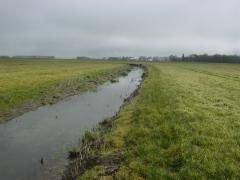OSU documents tiny aquatic species in flooded fields
Oregon State Extension Office [6]
Author: Chris Branam
Source: William Gerth
Seasonal agricultural streams and flooded ditches, remnants of when the Willamette Valley was one big wetland, are full of aquatic life.
Scientists at Oregon State University, partnering with the U.S. Department of Agriculture, ventured into farmers’ flooded fields and found a variety of crustaceans, snails, worms and aquatic insects. These organisms provide food for fishes and amphibians also found in these ephemeral waters.
These findings and others gathered over a decade’s study eroded the popular impression that agricultural streams and ditches are poor habitat and nothing of value lives there. The research also offers guidance for farmers who want to set aside some of their swampiest areas to improve conditions for the critters.
Studies of macroinvertebrates in streams that dry up for part of the year are rare, especially those that assess the effects of agriculture on temporary stream invertebrates, said William Gerth, a stream ecologist in OSU’s College of Agricultural Sciences who led the study of macroinvertebrates during the project.
“We weren’t sure what if anything we would find, but we found a lot of macroinvertebrates,” Gerth said.
The findings are published in the journal Agriculture, Ecosystems and Environment. Some of the discoveries include:
Streams and ditches with less watershed agricultural land-use contained more species of macroinvertebrates.
Channels with the most watershed agricultural land-use lacked many of the aquatic insects found in less agriculturally-influenced channels.
Stream and ditch bottoms with grasses and other plants had more invertebrates than those with exposed clay bottoms.
“There was an impact of agriculture on macroinvertebrate diversity in these lowland streams and ditches,” Gerth said. “The stream-bottom vegetation in agricultural systems increased the density of organisms but it doesn’t increase the diversity, unfortunately. But there is still a lot of life, which is important because the macroinvertebrates provide food for fish and amphibians.”
The research provides guidance for growers who are committed to the health of these temporary waters, Gerth said. That includes setting aside low areas of their fields that consistently flood and have low yields.
More than 25 farmers gave the researchers access to their fields over the course of the project.
In the 19th century people started draining the wetlands and created ditches in order to funnel the water to the nearest river that flowed into the Willamette River, according to Guillermo Giannico, a fisheries ecologist with the OSU Extension Service and Oregon Sea Grant, who was one of the researchers on the field project.
“The Willamette River wasn’t a single channel 150 years ago,” Giannico said. “There were many channels that formed a braided network on both sides of what we see today as a single river channel between Salem and Eugene. Farmers diverted the water from many of these secondary channels and drained the wetlands. But it still rains a lot during winter, and the water that falls on the fields has to go somewhere. It ends up in these ditches.
“We need to balance the needs of the wildlife and the needs of the farmers.”
Previous studies related to the project were published in the journals Wetlands, and Transactions of the American Fisheries Society.
The study was funded by the U.S. Department of Agriculture National Institute of Food and Agriculture, the USDA Natural Resources Conservation Service, the Oregon Seed Council and OSU, which partnered with Freshwaters Illustrated to produce a video about the project.
